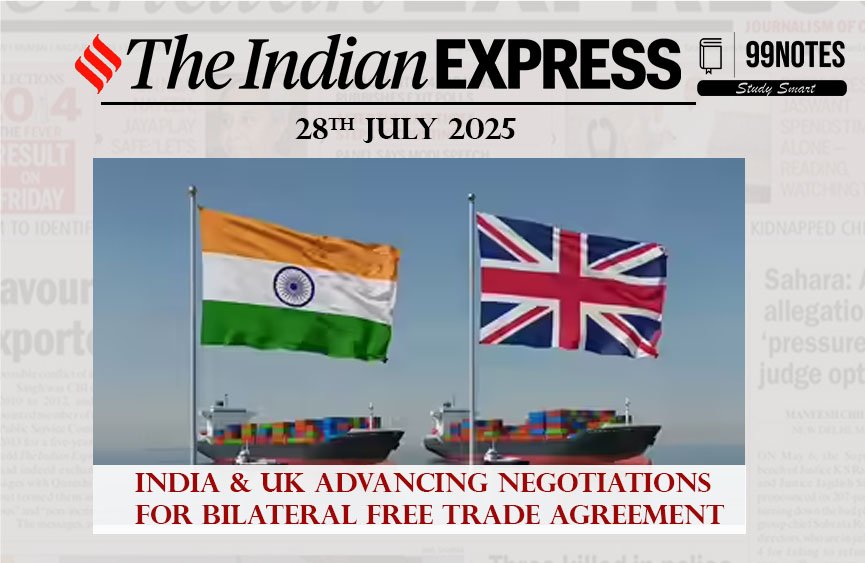28 July 2025: Indian Express Editorial Analysis
1. Carry it Forward
(Source: Editorial Page, The Indian Express)
| Topic: GS2 (International Relations, Bilateral Relations, Government Policies & Interventions), GS3 (Indian Economy, Export Policy, External Sector, Trade) |
| Context |
|
Introduction
-
The editorial highlights the significance of the India-UK trade talks, situating them within India’s overall export strategy.
-
It criticizes India’s traditional inclination toward protectionism and argues for ambitious, market-driven reforms to boost exports.
The Problem of Defensive Export Policy
-
India’s historical policy bias has focused more on shielding domestic markets than aggressively pursuing export market access.
-
Export growth is often seen as a side effect of domestic policy rather than a deliberate policy objective.
-
The editorial notes that India’s export structure is narrow, concentrated in a few products/sectors, and that there is a frequent resort to tariff and non-tariff barriers.
India-UK Trade Talks: An Opportunity
-
The FTA with the UK is presented as a test case for whether India can move beyond its traditional defensiveness.
-
The editorial suggests that the UK deal should serve as a model for future negotiations — signaling that India is open for business, ready to integrate with global value chains, and capable of providing policy certainty for investors.
Key Recommendations and Analysis
-
Shift Mindset: Move from defensive to confident export promotion.
-
Broaden Export Basket: Diversify into high-value products and sectors beyond the traditional focus.
-
Policy Certainty: Assure investors and trade partners of stable, long-term policies.
-
Reform Trade Institutions: Modernize laws, streamline procedures, and empower agencies tasked with trade promotion.
-
Global Integration: Use FTAs as vehicles for deeper integration into global value chains.
-
Export Ecosystem: Invest in trade infrastructure, logistics, and standards to support exporters.
Conclusion / Way Forward
-
The editorial concludes that India must seize the momentum of the UK FTA to showcase a new, confident trade posture.
-
Long-term success requires an export policy rooted in competitiveness, diversification, and integration, not mere tariff tweaks or ad hoc protectionism.
-
The article warns that failure to change risks relegating India’s exports to mediocrity even as global trade patterns rapidly shift.
| Practice Question: (GS-2 | 15 Marks | 250 Words)
India’s export policy has historically leaned towards protectionism rather than confident engagement with global trade. Critically analyze this assertion in the context of the ongoing India-UK Free Trade Agreement negotiations. What structural reforms are necessary for India to realize its export potential in the current global environment? |
Also Read: The Hindu Editorial Analysis- 28 July 2025
2. Be Uncertainty-Ready
(Source: Editorial Page, The Indian Express)
| Topic: GS2 (International Relations, Bilateral, Global Governance, Economic Diplomacy), GS3 (Indian Economy, External Sector, Trade Policy, Economic Reforms) |
| Context |
|
Introduction
-
The editorial discusses US tariff unpredictability, highlighting that global trade, especially for countries like India, faces new volatility due to abrupt policy shifts by major economies.
-
The piece uses the example of recent US tariff actions and legal developments that may shape trade relations beyond a single deadline.
The Nature of Trade Uncertainty
-
US trade policies, particularly tariff impositions and waivers, have become a source of global instability.
-
Decisions (e.g., by the US Court of International Trade) can change the trade status quo overnight, affecting Indian exporters’ access and competitiveness.
Overreliance on Trade Deals
-
Many policymakers see trade agreements (like FTAs with the US or the UK) as defenses against market shocks.
-
The editorial argues that such deals can offer only limited, and sometimes fragile, protection amid unilateral power plays by economic giants.
-
India’s approach of relying solely on pacts is critiqued as inadequate for true export resilience.
Structural Weaknesses in Indian Export Competitiveness
-
Indian export growth is constrained by weak competitiveness, supply chain inefficiencies, and lack of scale.
-
The editorial urges reforms to make Indian goods attractive globally—not just through preferential deals but through intrinsic quality, reliability, and innovation.
-
There’s a call for deepening domestic reforms: simplifying regulations, improving logistics infrastructure, and fostering R&D.
Strategic Recommendations
-
Build Resilience: Focus on making Indian industry strong enough to absorb external shocks, rather than seeking guarantees from trade partners.
-
Broad-based Reform: Align import and export policy with long-term national capabilities, not tactical or short-term gains.
-
Diversify Markets: Reduce overdependence on a few export destinations or products.
-
Internal Capacity Building: Promote skill upgradation, modernize infrastructure, and support technological advancement.
-
Institutional Strengthening: Reform trade dispute resolution systems and equip institutions to adapt swiftly to global regulatory changes.
Conclusion / Way Forward
-
The piece concludes that unpredictable trade policies, especially from influential nations, will be a persistent feature of the global economy.
-
India must use the current scenario as an opportunity to overhaul its export strategy and industrial base.
-
A robust, competitive, and diversified export sector—not just new trade deals—will be India’s best insurance against external shocks.
|
Practice Question: (GS-2 | 10 Marks | 150 Words) |
Read more – 26 July 2025 : Indian Express Editorial Analysis

